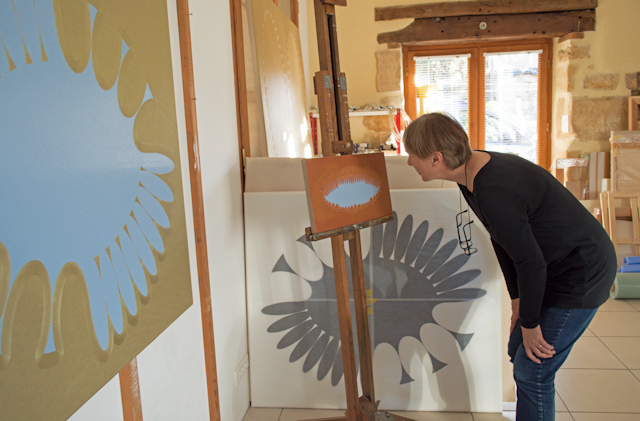“These decorative curves are only painted rugs which would be better to sit on than to admire hanging on a wall,” proclaimed the dadaist Hugo Ball, mocking the abstract paintings of Wassily Kandinsky. Ball admired the paintings of the Russian painter who sought to express “internal truths”, but found them, at times, too decorative. Which was about the worst insult you could level at a budding modernist painter in the first decades of the 20th century.
The likes of Kandinsky sought something essential and true. Decoration was, by contrast, arbitrary – something added on after the important work was done. Even worse, it was deceptive to the eye, trivial and associated with the applied arts. In a word, it was feminine.
Things have changed, thankfully, although the odd art critic still gets nervous faced with a painting that flirts with the decorative. By all accounts, this nervousness might well have amused the British abstract painter Jane Harris.

Harris, who died at the age of 65 in 2022, belonged to a generation of painters who did not seek internal truths, but chose to play with the wealth of visual effects and associations offered by decoration.
Since the early 1990s – when art in the UK was dominated by the knowing, nudge-nudge, tabloid-baiting of the Young British Artists (YBAs) – Harris patiently, uniquely, and not without humour, explored decoration through abstract painting.
Contemporary art trends moved elsewhere after the YBAs. There was (another) resurgence of painting about 20 years ago, but Harris, working quietly in France far away from London, did not feature. Thankfully, a handful of gallerists and collectors saw the value of her work and continued to support her.

But now, in Ellipse, a new exhibition at Frac Nouvelle-Aquitaine MÉCA in Bordeaux, eight of Harris’s oil paintings are on display, and very much worth seeing in person.
Illusion and ambiguity
Critic Barry Schwabsky called her work “rococo minimalism” because it combines the pared-back repertoire of the latter with the frills and play of the former. That said, Harris’s works are probably more baroque than rococo in their exploration of illusions and ambiguous shapes and surfaces.
She found a supple motif in the ellipse, which she stretched, squashed, folded, rotated and repeated, just as one might do with an ornamental motif when composing a decorative frieze or pattern. This manipulation of shape brings her ellipses to life – and all the drama happens at their edges.

Harris breaks their neat borders with indentations, frills, scallops, petals and spikes. Some are constant in size, while others grow, diminish or even appear to rotate and flip. Sometimes the border is a different colour to both the ellipse and the field of paint in which it sits, but most often Harris works with only two colours, inside and outside the ellipse.
The paint on the outside is then brushed to follow closely the contours of the edge, so that a part of the outside becomes a part of the border, giving the look of something carved or embossed upon the surface. This makes her ellipses seem to fold or twist, to zoom in or out. The effects are perplexing, surprisingly varied, and always playful.
Harris often mixes in metallic paint, giving a sheen and shimmer to her bold, acidic colours. Her pairings of colours are odd to say the least, but they derive from her observations of the world around her, glimpses of contrasted colours or strange light effects that might issue from something quite banal, like water in a sink, books on a shelf or clothes drying on a line.
She then abstracts from these moments to hold on to the feeling that she described as “not quite [being] sure where things are in space”. What Harris loved about painting was that it could play with that ambiguity, “whether it is a form or a mark or an area in a painting – [it] can do more than one thing at once … It has that flexibility or that variability that I think is just wonderful, and I’m still in love with the way painting can do that.”

The eight oil painting on display include the series of Familiars (2014-18), arranged in tall pairs along a wall facing the Garonne river, where they shimmer uncertainly in changing natural light.
On the adjoining wall is The Fugitives (2008), whose title points to the variability and play that Harris so loved. Here, a pair of silvery ellipses catch the light like pools in a gentle breeze. In the corridor leading to the gallery are Look There, Look There (2014) and Buff and Tan (2005), compositions of four almost spherical ellipses that play more calmly in the artificial light.
The exhibition also includes several drawings and watercolours by Harris which combine ellipses in more elaborate, interlocking patterns of cool graphite and fluid pigment.
It is especially important to view these paintings and drawings in person, where their array of effects and associations can be fully explored and enjoyed. This Bordeaux exhibition is long overdue. I hope it will lead to Harris’s painting gaining the recognition it deserves, finally.

Looking for something good? Cut through the noise with a carefully curated selection of the latest releases, live events and exhibitions, straight to your inbox every fortnight, on Fridays. Sign up here.

